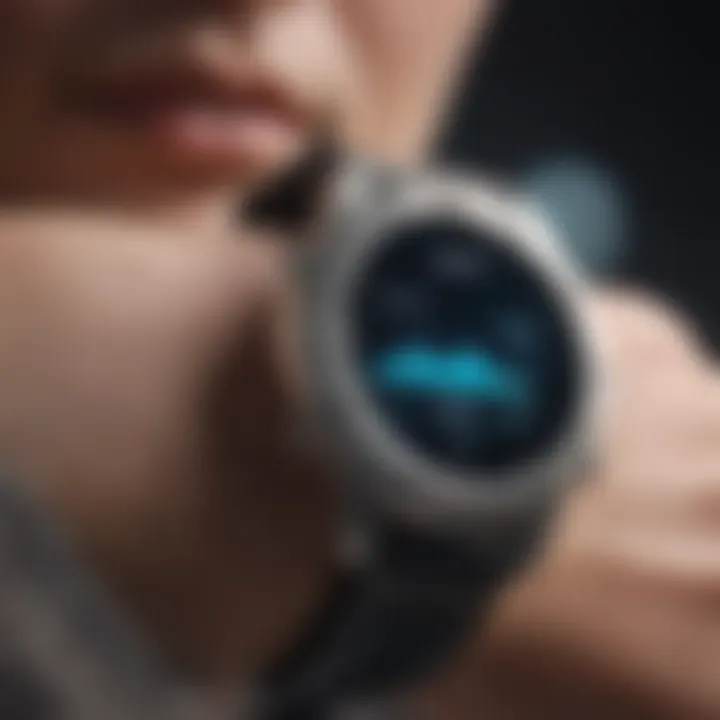Wearable Monitors: Transforming Health Monitoring Today


Intro
Wearable monitors have emerged as transformative tools in the realm of health and fitness. These compact devices, often worn on the body, track a variety of physiological metrics. This article explores their functionalities, applications, and implications in modern research. The prevalence of wearable monitors in daily life has spurred interest across multiple disciplines, including medicine, engineering, and data science.
With technological advancements, today’s monitors offer unprecedented accuracy and accessibility. However, the rise of such devices brings both opportunities and challenges. Questions around data security, user interaction, and ethical considerations increasingly demand attention. This discussion will unfold key points relevant to understanding the importance of wearable monitors, culminating in a detailed examination of their future within health monitoring and research contexts.
Article Overview
Purpose of the Article
The primary aim of this article is to dissect the multifaceted world of wearable monitors. By providing an in-depth analysis, the article seeks to equip readers with essential knowledge. This includes how these devices function, their various uses, and the broader impact they have on health monitoring and scientific research. The investigation goes beyond mere functionalities, engaging with the ethical, technical, and social dimensions inherent in this evolving field.
Relevance to Multiple Disciplines
Wearable monitors intersect numerous fields. Their implications reach healthcare professionals, researchers, athletes, and even everyday consumers. Understanding the interplay between technology and health is crucial in today’s information-driven society. Notably, the data collected by wearable devices informs clinical decisions, enhances research quality, and supports personal health management.
Key areas of relevance include:
- Health Monitoring: Continuous tracking of vitals enables proactive healthcare.
- Scientific Research: Collection of large datasets from users aids in findings related to health trends.
- Public Health: Aggregated data informs policies and health interventions.
Research Background
Historical Context
The evolution of wearable monitors dates back several decades. Initially, these devices were rudimentary, primarily focused on heart rate and step counting. Early models were bulky and limited in functionality. Over time, advancements in sensor technology, miniaturization, and wireless connectivity have transformed wearable devices into sophisticated health tools.
Key Concepts and Definitions
Understanding wearable monitors requires familiarity with several key concepts:
- Biometric Data: Information gathered from users’ bodies, such as heart rate, sleep patterns, and calories burned.
- User Interface: The means by which users interact with their device, typically via apps on smartphones.
- Data Security: Concerns related to the protection of sensitive health information collected by wearable devices.
"As wearable technology evolves, so does the need for ethical considerations surrounding privacy and data ownership."
"As wearable technology evolves, so does the need for ethical considerations surrounding privacy and data ownership."
This exploration will provide insights into how these key concepts intertwine with the overarching narrative of wearable monitors.
Prolusion to Wearable Monitors
Wearable monitors represent a significant evolution in how we track and manage health and wellness. These devices have shifted the focus of health monitoring from passive observation to active self-tracking. They help individuals keep tabs on various health metrics, such as heart rate and activity levels, in real time. This section aims to underscore the importance of wearable monitors, highlighting their benefits and the considerations that accompany their usage.
Defining Wearable Monitors
Wearable monitors are technological devices that can be worn on the body to assess physical activity and health-related metrics. They come in various forms, including wristbands, smartwatches, and even clothing embedded with sensors. Each device is designed to collect data on bodily metrics and convert it into easily understood information. The primary function of these monitors is to encourage health awareness and timely interventions.
The data collected can include heart rate, sleep patterns, daily steps, and caloric consumption. This data can be invaluable for fitness enthusiasts, healthcare professionals, and researchers alike by providing insights into a person’s overall health and guiding lifestyle choices.
Historical Context
The concept of wearable monitors is not entirely new. The foundations can be traced back to the early 20th century when rudimentary health monitors were introduced. Pedometers, for example, tracked steps taken as far back as the 1960s. With advancements in technology, especially in the last two decades, the wearable technology landscape has dramatically transformed.
In the late 1990s and early 2000s, early prototypes began to emerge. As smartphone technology advanced, integration of sensors and applications allowed for vast improvements. In 2015, the market saw an explosion of fitness trackers such as Fitbit and wrist-based heart rate monitors. This surge opened the floodgates for a variety of devices now commonly used for health tracking. Current advancements continue to push boundaries. From comprehensive sleep analytics with devices like the Oura Ring to real-time heart rate monitoring with Apple Watch, the wearable monitor market is thriving and evolving rapidly.
The Technology Behind Wearable Monitors
The technology behind wearable monitors is vital for understanding their functionality and impact on health monitoring. It encompasses various elements such as sensor technology, data connectivity, and the methods used to process and visualize the collected data. These aspects determine how effectively wearables serve their users—be it fitness enthusiasts or patients with chronic diseases. The integration of sophisticated technologies facilitates the real-time monitoring of physiological parameters, enabling timely interventions and enhancing the overall user experience.
Sensors and Data Collection
Sensors are the core components of wearable monitors. They enable the collection of diverse physiological data such as heart rate, temperature, and physical activity. Common types of sensors include accelerometers, gyroscopes, and photoplethysmography sensors. Each sensor captures specific data, driving the overall accuracy and reliability of the monitor.
The significance of accurate data collection cannot be understated. Precision ensures the effectiveness of health monitoring, allowing users to make informed decisions about their health. For example, a fitness tracker utilizing an accelerometer barometer can accurately estimate the number of steps taken during a day’s activities, resulting in valuable insights for users aiming to enhance their fitness levels.
Moreover, the implementation of advanced sensor technology enables the continuous monitoring of chronic conditions. Devices such as the continuous glucose monitors offer real-time data that is crucial for individuals managing diabetes. This real-time feedback provides better control and management options, potentially reducing hospital visits and improving quality of life.
Connectivity and Data Transmission
Connectivity underpins the functionality of wearable monitors. Most devices utilize Bluetooth or Wi-Fi to transmit collected data to smartphones or cloud platforms. This connectivity not only allows users to access their information remotely but also enhances the analytical capabilities of wearable monitors.


The ability to pair with mobile applications creates opportunities for sophisticated data analysis and feedback mechanisms. Users have access to their historical data, trends, and patterns, facilitating deeper insights into their health behaviors. Furthermore, seamless connectivity aids in integrating various health applications and devices, providing a holistic view of the user’s health trajectory. However, users must be aware of the potential risks such as data security issues that may arise with such integrations.
Data Processing and Visualization
Data processing and visualization are crucial in transforming raw data into actionable insights. Wearable monitors collect vast amounts of data that must be processed to be relevant to users. This involves analyzing the data through algorithms that identify patterns or anomalies in the physiological data collected.
The visualization of this processed data greatly influences how users engage with their health information. Well-designed dashboards and apps interpret complex datasets through graphs and charts, making it easier for users to understand their health. For instance, a user might receive a clear visual representation of their heart rate variability over a month, indicating their cardiovascular health trends.
In an era of information overload, the importance of intuitive data visualization cannot be overlooked. It helps users understand their health data without needing advanced analytical skills, making health management more accessible for everyone.
In summary, the technology behind wearable monitors—encompassing sensors, connectivity, data processing, and visualization—is integral to their functionality. As technology advances, the potential for wearables to contribute significantly to health monitoring will only expand.
In summary, the technology behind wearable monitors—encompassing sensors, connectivity, data processing, and visualization—is integral to their functionality. As technology advances, the potential for wearables to contribute significantly to health monitoring will only expand.
Types of Wearable Monitors
The classification of wearable monitors plays a crucial role in understanding their impact and functionality in health and fitness. Each type is designed with specific purposes in mind, catering to diverse user needs and preferences. This section will explore three primary categories of wearable monitors: fitness trackers, smartwatches, and medical wearables.
Fitness Trackers
Fitness trackers are perhaps the most common form of wearable technology available today. They emphasize monitoring physical activities and measuring fitness-related metrics. Features usually include step counting, heart rate tracking, and calorie expenditure. Some devices offer advanced functionalities, such as GPS tracking for outdoor activities.
The growing interest in personal health and wellness has driven the demand for fitness trackers. Users of these devices typically benefit from real-time feedback, which can encourage them to stay active and adopt healthier habits. Moreover, data collected over time can help individuals understand their fitness levels better, assisting in goal setting and progress tracking. Users can compare their performance on different metrics, which can motivate them to improve.
However, while fitness trackers are beneficial for individual health, they must be used carefully. Over-reliance on the data might lead to unnecessary stress or injury. It is essential to strike a balance between data and intuitive understanding of one's body.
Smartwatches
Smartwatches are multifunctional wearable devices that combine the features of traditional watches with advanced technology. Beyond basic fitness monitoring, they serve as communication tools, providing notifications for calls, messages, and social media updates. Smartwatches often include fitness tracking features similar to fitness trackers but add more functionalities, such as mobile payment and voice assistance.
The integration of apps is a significant advantage of smartwatches. Many users appreciate being able to customize their devices with applications that suit their lifestyle. For instance, users can track their workouts, meditate, or even monitor their heart health. Because of this versatility, smartwatches have attracted attention from various demographic groups, including those seeking convenience and technology integration.
Although smartwatches provide many benefits, users should consider battery life and data security. Frequent synchronization with smartphones can drain the battery quickly, which may impact usability. Security issues, especially regarding personal data, are another consideration requiring careful attention.
Medical Wearables
Medical wearables are specialized devices designed primarily for health monitoring and clinical applications. They serve a critical role in tracking patients' health conditions over time, providing healthcare providers with vital data. These devices can monitor vital signs, such as heart rate and blood pressure, and monitor specific health conditions, like diabetes or chronic respiratory issues.
One of the main advantages of medical wearables is their ability to facilitate early detection of health issues. Continuous data streams allow healthcare professionals to intervene promptly. This real-time monitoring can significantly improve patient outcomes, particularly in chronic disease management.
Nevertheless, medical wearables come with challenges. They often require regulatory approval, and not all devices are compliant with health standards. The accuracy of data collected by these wearables is also a concern, with potential implications for patient safety. Data confidentiality and patient consent are significant considerations when using these devices in clinical settings, as they contain sensitive health information.
"Adopting wearable technology in healthcare presents a shift in how health data is collected and managed, increasing the potential for proactive intervention."
"Adopting wearable technology in healthcare presents a shift in how health data is collected and managed, increasing the potential for proactive intervention."
Overall, understanding the types of wearable monitors is essential for recognizing their functionalities and implications in health monitoring. Each variety offers unique benefits and drawbacks, which must be considered for effective utilization. This awareness aids users in selecting the right devices that align with their health objectives.
Applications of Wearable Monitors
The applications of wearable monitors represent a vital aspect of modern health technology. These devices are not only revolutionizing personal health management but they also play a significant role in clinical settings. By extending their functionalities beyond fitness tracking, wearable monitors are now implemented in various healthcare strategies. Understanding their usage in health and fitness monitoring, chronic disease management, and remote patient monitoring reveals their multifaceted benefits.
Health and Fitness Monitoring
Health and fitness monitoring via wearable devices provides an essential foundation for personal health tracking. Users harness these devices to gain insights into their physical activities, vital signs, and overall wellness.
Heart Rate Monitoring
Heart rate monitoring is a significant function of many wearable monitors. This feature allows individuals to track their heart rate in real time, promoting awareness of cardiovascular health. It is especially beneficial for people engaged in regular exercise or those managing heart conditions. The key characteristic of heart rate monitoring is its ability to provide continuous readings, actionable insights into exercise intensity, and recovery periods. This immediacy makes it a popular choice among both fitness enthusiasts and clinical users.
However, a unique feature of this technology may also lead to inaccuracies due to sensor placement or movement. Users might need to regularly check sensor calibration to ensure that collected data is reliable.
Activity Tracking
Activity tracking encompasses the measurement of daily movements, including steps taken, distance traveled, and calories burned. This aspect is crucial for users aiming to maintain or improve their physical health. The main advantage of activity tracking is its ability to motivate users to achieve their fitness goals through personalized data feedback. For this reason, many people consider this feature essential for encouraging physical activity in their routine.
Still, while useful, activity tracking can have a downside. Users might become overly focused on data collection instead of enjoying their exercises. This might detract from the overall experience.
Sleep Monitoring
Sleep monitoring is another critical application of wearable devices. It provides insight into sleep patterns, duration, and quality. This feature is particularly valuable for individuals seeking to understand their sleeping habits. The primary benefit of sleep monitoring is the potential for improved health outcomes, as good sleep is essential for overall well-being.


Users appreciate sleep monitoring for its ability to suggest lifestyle changes to enhance sleep quality. Nonetheless, sleep tracking technologies can vary widely in accuracy, which might affect users' trust in the data.
Chronic Disease Management
Wearables shine in chronic disease management, where they can significantly improve patient outcomes. These devices are used to monitor various health metrics vital for managing long-term conditions.
Diabetes Management
Wearable technology for diabetes management assists patients in tracking their blood glucose levels continuously. This makes it easier for individuals to manage their condition effectively. Key characteristics include real-time alerts for abnormal glucose levels and integration with mobile apps for detailed tracking. This capability is beneficial because it empowers users to make informed decisions regarding their health.
However, there is a downside. Costs for continuous glucose monitoring devices may be high, limiting accessibility.
Cardiac Health
Wearable devices also play a crucial role in monitoring cardiac health. Features like ECG recording help detect irregular heart rhythms, offering immediate data. This is vital for those at risk of heart disease. The key advantage here is the potential for early detection of serious health issues, allowing timely medical interventions.
Despite the advancements, these devices may have limitations regarding accuracy and specificity. Users should be cautious and consult professionals based on the readings.
Asthma Monitoring
Wearables can aid in asthma monitoring by providing insights into environmental triggers and lung function. They track air quality and respiratory rates, making it easier for individuals to manage their asthma. The unique advantage of asthma monitoring is its capacity to alert users to potentially hazardous conditions in real time, thus helping in preventing asthma attacks.
However, the effectiveness of asthma monitoring may depend on user compliance and how regularly devices are used.
Remote Patient Monitoring
Remote patient monitoring is an emerging field enhanced by wearable devices. These monitors allow healthcare providers to track patients' health metrics from afar. This capability improves the efficiency of care and supports chronic condition management. As a result, both patients and providers benefit from increased access to timely data.
Monitoring patients remotely can reduce hospital visits and improve adherence to treatment plans.
Monitoring patients remotely can reduce hospital visits and improve adherence to treatment plans.
Wearable devices provide the necessary infrastructure for this growing area in healthcare. Overall, the applications of wearable monitors contribute significantly to personal health management and chronic disease control, offering various metrics to increase health awareness and proactive healthcare decisions.
User Experience with Wearable Monitors
Understanding the user experience with wearable monitors is vital for their successful integration into everyday life. This aspect encompasses the design, usability, and overall interaction the user has with the device. Not only does it determine how easily individuals can adopt these technologies, but it also influences the effectiveness of the data collected. The better the user experience, the more likely individuals are to consistently use these monitors, leading to richer data acquisition and improved health outcomes.
Design and Usability
The design and usability of wearable monitors play a crucial role in determining user satisfaction. A device that is cumbersome or visually unappealing may deter individuals from using it regularly. Elements such as weight, comfort, and intuitive interfaces are key considerations. For instance, a fitness tracker that feels heavy or restricts movement will likely see less engagement from users.
Furthermore, usability goes beyond just physical design. It includes how easily users can set up and navigate the device. A complicated onboarding process can lead to frustration. Companies should aim to streamline this experience to ensure users can access their data and functionalities effortlessly.
User Engagement and Adoption Rates
User engagement with wearable monitors heavily influences their adoption rates. It involves more than just wearing the device; it requires interaction with its functions and features. Devices that provide immediate feedback, such as heart rate readings during exercise, encourage ongoing use.
To promote higher adoption rates, developers should focus on creating personalized experiences. For example, allowing users to set goals and receive reminders can significantly enhance engagement. Users are more likely to stick with their monitors if they feel the device is tailored to their unique needs.
It is also essential to consider external factors such as social influence. Encouraging sharing achievements on platforms like Facebook or Reddit may stimulate usage among peers. This social aspect can create a supportive community that fosters commitment to health objectives.
Effective user experience design leads to higher engagement and improved health outcomes.
Effective user experience design leads to higher engagement and improved health outcomes.
In summary, the user experience with wearable monitors is pivotal in determining their success. Focus on design and usability ensures that users stay engaged, which in turn influences adoption rates and the effectiveness of the monitors in health management.
Data Security and Privacy Issues
In the realm of wearable monitors, data security and privacy issues stand as critical components. As these devices continuously collect sensitive health data, ensuring the protection of this information is paramount. The integration of wearable monitors into daily life creates a dynamic interplay between convenience and the vulnerability of personal data. This section delves into the complexities involved in safeguarding user data and emphasizes the importance of privacy in the user experience.
Data Breaches and Vulnerability
Data breaches have become increasingly common, affecting various sectors including healthcare. Wearable monitors, which often transmit data through wireless networks, are susceptible to these threats. Understanding the risks involved is essential for both users and manufacturers. Insecure applications, weak passwords, and outdated software can all lead to unauthorized access to personal health information.
Several high-profile data breaches have demonstrated the potential consequences. For instance, the exposure of user data can lead to identity theft or misuse of sensitive health information. With the increase in data collection from wearable devices, the potential attack surfaces for cybercriminals grow. Therefore, manufacturers must invest in robust encryption and security protocols to mitigate these risks. Furthermore, continuous monitoring and updates are necessary to counter threats that evolve over time.
User Consent and Data Ownership
Another fundamental aspect of data security involves user consent and data ownership. Users of wearable monitors should have full clarity over what data is being collected, how it is used, and who has access to it. Consent should be informed, meaning users understand the implications of sharing their data before agreeing to any terms. Sadly, many users often overlook long agreements or privacy policies that accompany device setup, which can lead to unintentional consent.


In discussions about data ownership, questions arise about who ultimately controls this sensitive information. Many individuals believe they should have rights over their data, including the ability to delete or request control over their personal health information. This calls for a reevaluation of current policies to ensure adequate protection of user rights.
"As wearable technology advances, so too must our strategies for protecting the data it generates. It's not just about innovation; it’s about trust."
"As wearable technology advances, so too must our strategies for protecting the data it generates. It's not just about innovation; it’s about trust."
Ethical Considerations in Wearable Monitor Usage
The integration of wearable monitors into health and fitness ecosystems raises several ethical questions that need to be addressed. These considerations are crucial in understanding how these devices impact user autonomy, data privacy, and the overall doctor-patient relationship. As wearable technology evolves, stakeholders must ensure that ethical standards are met to maintain trust and transparency.
Informed Consent and Autonomy
Informed consent is a foundation of ethical practice in healthcare. It entails providing individuals with all relevant information regarding the use of their data and the implications of wearable technology. Users of wearable monitors should be fully aware of what data is collected, how it is used, and with whom it may be shared. The complexity of data usage can lead to confusion among users, making informed consent challenging to obtain.
The concept of autonomy is also key here. Users must have the freedom to choose whether to engage with these devices. Some may feel coerced into using wearables by societal pressures or health incentives, which can compromise their autonomy. Ensuring that individuals make empowered choices regarding their health data is vital for ethical compliance. All stakeholders must work to make the consent process straightforward, accessible, and respectful of user rights.
Impact on Patient-Provider Relationships
Wearable monitors can influence the dynamic between patients and healthcare providers significantly. While these devices can enhance communication and data flow, they can also introduce challenges. Doctors might rely too heavily on data from wearables, leading to a reduction in face-to-face interactions. Such a shift can impact patient trust and diminish the nuance required in diagnosing and treating patients.
Patient providers must actively preserve the integrity of the patient-provider relationship. This includes taking the time to discuss information collected from wearables within consultations, both to validate user concerns and to build rapport. Transparency in how wearable data informs healthcare decisions is essential. Creating an environment where patients feel they can voice their concerns or thoughts will facilitate a healthier relationship moving forward.
"Ethical considerations in the use of wearable monitors are not merely regulatory hurdles; they represent a commitment to user rights and enhanced patient care."
"Ethical considerations in the use of wearable monitors are not merely regulatory hurdles; they represent a commitment to user rights and enhanced patient care."
In summary, ethical considerations in wearable monitor usage encompass critical elements of informed consent and the evolving patient-provider landscape. Addressing these factors is essential for building a responsible framework around the adoption of wearable technology in healthcare settings.
Future Trends in Wearable Monitor Technology
The landscape of wearable monitors is evolving rapidly. Advances in technology are critical to this evolution. Understanding these future trends is essential as they will shape how we interact with these devices and what capabilities they have. Current wearable monitors primarily focus on tracking basic health metrics. However, future trends will enhance their functionality and reliability. They will also impact healthcare delivery as well as personal health management.
Advancements in Sensor Technology
Sensors are at the heart of wearable monitors. They capture vital information like heart rate, movement, and even blood sugar levels.
Recent advancements include miniaturization and increased accuracy. For example, newer sensors can now measure parameters with remarkable precision while remaining compact. This change is vital for improving user comfort and device wearability. Furthermore, developments in biosensors allow for continuous monitoring of metabolic markers. This could lead to early detection of health issues.
Key improvements in sensor technology include:
- Enhanced Accuracy: Sensors now provide more reliable data, enabling better health decisions.
- Multi-functionality: Devices like the Apple Watch incorporate ECG and blood oxygen monitoring.
- Battery Efficiency: Newer designs extend the life of devices, allowing longer wear.
These advancements are significant. They have the potential to facilitate proactive health management and improve outcomes for patients.
Integration with Artificial Intelligence
Artificial Intelligence (AI) is reshaping the landscape of wearable monitors. The integration of AI technologies enhances the capability of these devices to analyze and interpret data. It helps transform raw data into actionable insights.
AI can process vast amounts of data quickly. In the context of wearable technology, AI algorithms can provide personalized recommendations based on users' health patterns. This can guide decisions regarding exercise, nutrition, and medical needs.
Some notable benefits of integrating AI with wearables are:
- Predictive Analytics: AI can anticipate health changes before they become critical.
- Personalization: Tailored insights based on individual behavior improve user engagement.
- Efficient Data Management: AI assists in filtering relevant information, making it easier for users to understand.
The collaboration between AI and wearable monitors presents a promising future. It allows for more personalized healthcare solutions and could revolutionize the way individuals manage their health.
The End
In this article, we have navigated through the complex landscape of wearable monitors. These devices are more than just gadgets; they represent a significant leap in the way health monitoring is approached today. The importance of understanding wearable monitors lies in their ability to seamlessly integrate into daily life, enabling users to take charge of their health with minimal effort. This balance between accessibility and functionality makes wearable monitors essential in today's fast-paced world.
Summary of Findings
We explored various aspects of wearable monitors, emphasizing how they function through sophisticated sensors and data processing methods. Key findings from this research highlight the diverse types of wearable devices available, including fitness trackers, smartwatches, and medical wearables. Each device serves unique purposes, addressing different health needs and preferences.
Additionally, applications range from basic fitness tracking to critical chronic disease management. The varied uses demonstrate a significant impact on prevention and early intervention in health issues. Furthermore, ethical considerations regarding data security and user privacy were discussed, indicating the need for stringent measures to protect sensitive health data. The integration of artificial intelligence into wearable technology will likely advance these devices beyond their current capabilities, enhancing their effectiveness.
Implications for Future Research
The future of wearable monitors offers vast potential for exploration. Further research is needed to refine technologies, especially in sensor design and data analytics. Investigating the long-term effects of wearable technology on user behavior and health outcomes will provide valuable insights into their efficacy.
Moreover, studies should examine the ethical implications, ensuring that advancements do not compromise user trust. As research progresses, establishing clear guidelines for data use and sharing will become critical. The evolving landscape of wearable technology necessitates ongoing scrutiny to address these concerns while maximizing benefits for users.
"Wearable monitors have the potential to revolutionize healthcare, but we must ensure that ethical standards keep pace with technological advancements."
"Wearable monitors have the potential to revolutionize healthcare, but we must ensure that ethical standards keep pace with technological advancements."
Overall, this article serves as a comprehensive introduction to wearable monitors, highlighting their current impact and future possibilities in health monitoring. Engaging with these devices not only empowers users but also shifts paradigms in healthcare delivery.



